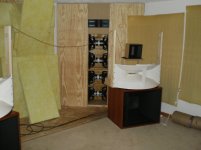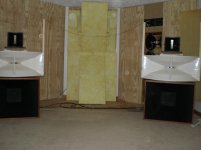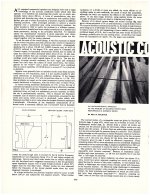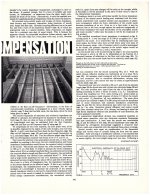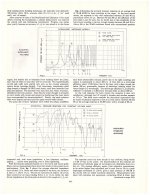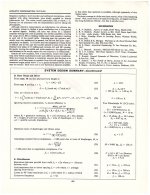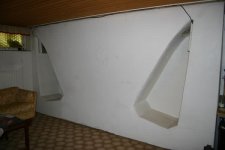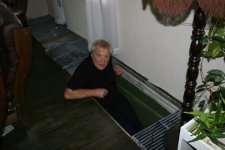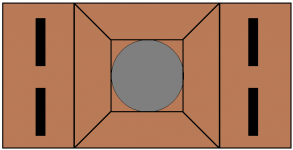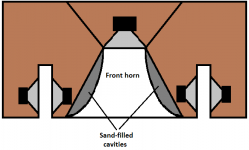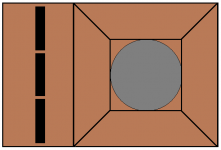I'd rather have multiple distributed subs.
Sort of depends on the intended pass-band and the room size, no?
Corner subs in a small to moderate size listening room that don't start their operation until below most fundamentals (..say <30 Hz), might be the better solution. In this context they would actually be "sub-woofers", whereas those bass fundamentals should be characterized as *bass*-boxes: ie. multiple distributed *bass* drivers (..and often even that isn't correct because many so-called subs are being operated well into the lower midrange.)
Also, you can get quite a bit more (objective) performance with a near-field solution.. but at least in stereo it's generally a single-listener only solution.
What will be BEST in bass is so room dependent. I admire even envy those who own a big home and can build in an awesome horn but alas when you don't then you have to opt for alternative. One of the better one's I once upon a time had was a single servo tucked into an unused chimney flanked by the stereo mains with a bit of fiddling to get the phase right. Phase does seem to be quite important to get real integration between sub and mains. In this particular case almost no one even noticed that the sub was behind the fire screen in the chimney. But everyone noticed what a spacious 3D sound field we had anywhere in the room with the right LP and CD playing. Alas I've had to move twice since that home and every house has its issues for getting great sound.
The thing I liked about the bass horn was having the in phase coherent in a perfect world) radiation propagating out across the end wall and flank walls. I think phase in the bass is as important as the rest of the delivery must be in phase with the mid mid/treble horn. I still appreciate your subs where you can tune and phase by placement. And a corner is an otherwise wasted area in many rooms. I prefer the horn effect with organ stops in particular giving a synergy of being delivered down a pipe.
Phase coherency at LFs in a small room
I prefer smooth boom free bass and no fixed position source in a small room is going to do that. Have you ever seen the response in a typical small room at LFs? A corner horn is not going to change that. It won't be any different than a monopole at the same position except for some internal standing waves from the short horn. The corner horn can only be more colored than the monopole, never less.
And don't get me started on "It has lower THD".
If all you listen to is pipe organ music then what you need is a pipe organ, not a stereo.
Last edited:
In general I don't see why that would be. A bigger room will require a more powerful set of sources, but the number of them would be about the same. The LF capability again only depends on how much headroom (amp power, power handling and excursion) you have in the subs - how much EQ you can apply at VLFs. Hence the only thing that room size and bandwidth dictate is the amp power and power handling of the sub sources themselves.Sort of depends on the intended pass-band and the room size, no?
I can get 110 - 120 dB at 20 Hz in my room with three 12" subs. But my situation is extremely smooth unlike any small number of subs solution is going to be.
Don Keele once pointed out how inefficient horns were for space. He concluded exactly what I have done for years and that is to use monopoles. With modern DSP EQ and cheap amp power monopoles will beat any other LF solution since they are infinitely configurable.
Also, you can get quite a bit more (objective) performance with a near-field solution.. but at least in stereo it's generally a single-listener only solution.
The near field solution has a lot of merit if you can do it. I can't. From what I have seen not many can. I think it's more of a mono-listener solution, not a six person HT like mine.
Keeping good company
Please see the picture of my system that was "almost there". This was my incarnation about 18 months ago. The driver in the short (quasi) tractrix horn is the Altec 515-8G. It had wonderful articulate lower mid-range and could easily keep up with the white whales, but severly lacked in the "lower" mid-bass punch that my ppsl hybrids have (shown in a previous picture). Note the 8x15 IB sub-bass, and my findings are the same as what was posted by "bappe" in #10590. So, returning to the challenge faced by getting all the mid-bass right, I have to agree with you, Lynn, "band-splitting" to where I will add some "helper" woofer(s) to augment the area below 150 Hz is my plan as well.
A minor point. With the 150~200 Hz cutoff in mind, it should be possible to design a short horn (no deeper than the AH425) that takes advantage of the floor image; in essence, a Tractrix, exponential, or LeCleac'h that is a dual-driver horn, with the lower half of the horn a virtual floor image. That should retain pattern control, along with reduced driver excursion, down to the cutoff frequency.
I understand what the bass horn guys are getting at. The diaphragm in a horn-loaded system is constant-velocity, not constant-acceleration, like a direct-radiator. Translated into English, that means less excursion, more headroom, lower IM distortion, etc.
The point about IM distortion is important. Since direct-radiators are constant-acceleration devices, that means excursion increases 4X for every octave drop in frequency. (Constant-velocity means excursion only increases 2X for every octave drop in frequency.) The practical effect is that low frequencies always intermodulate higher frequencies, creating close-in sidebands. With real musical sources instead of test tones, with a far more complex program spectra, IM distortion sidebands greatly outweigh harmonic distortion.
The worst-case condition for IM distortion is loud, spectrally dense music played through a small full-range driver; bass content will strongly intermodulate higher-frequency content. Perception of distortion tends to follow the Fletcher-Munson curve, so distortion in the 1~5 kHz range is most audible (and annoying), while the peak energy in the musical spectrum is around 200~800 Hz. Bass intermodulates the higher frequencies on a program-dependent basis; not so bad with sparse spectra, not so good with symphonic and choral music. There's a reason that hifi demos at shows control the program content.
The strongest reason to band-split is reduction of IM distortion, since the MF or HF reproducers are never exposed to the energy of the 200~800 Hz region. Horn loading can also make a difference, since excursion in the 200 Hz region is significantly reduced. A bass array does the same thing, since mutual coupling raises efficiency (reducing excursion), and there are more drivers to share the load.
Please see the picture of my system that was "almost there". This was my incarnation about 18 months ago. The driver in the short (quasi) tractrix horn is the Altec 515-8G. It had wonderful articulate lower mid-range and could easily keep up with the white whales, but severly lacked in the "lower" mid-bass punch that my ppsl hybrids have (shown in a previous picture). Note the 8x15 IB sub-bass, and my findings are the same as what was posted by "bappe" in #10590. So, returning to the challenge faced by getting all the mid-bass right, I have to agree with you, Lynn, "band-splitting" to where I will add some "helper" woofer(s) to augment the area below 150 Hz is my plan as well.
Attachments
In general I don't see why that would be.
I was thinking in terms of small room dimensions and resulting modes.. Probably only 2 to deal with and likely very near each other in frequency - makes them easy to eq.. Plus, it works for multiple positions. Again though, very low freq. production only.
nothing wrong with this bass solution , if going not-horn route , I suppose .......

Alexander is no longer using this bass module. The problem with the original version (as demoed at RMAF two years ago) was the missing woofer; it's not a closed box, but effectively a vented box, since one of the woofers is missing, and the opening left by the woofer was the de facto vent. Result, very high box tuning that interfered with the crossover to the cylindrical array of 2" aluminum-cone mid drivers. I don't know if he did a closed-box version of the bass module or not.
He's now going the OB route with reaction-cancelling pairs of woofers. The part I'm borrowing is the reaction cancellation, but not going down the OB route.
What about PPSL woofer system like DJK proposes. That really is a bass system, but if you are going to spectrally divide up the frequencies anyway, no worries. The resonance is defined by the "slot" dimensions, which with some creativity or foam filling can be reduced to a much higher frequency. You get the reactance cancelling and according to DJK almost as good of bass as horns.
Phase coherency at LFs in a small room- I'm sorry, I just don't see how that is possible, or desirable. Small rooms at LFs are a steady-state situation and phase is not really important temporally. It is a factor spatially, but that's why you use several as this averages it all out.
I prefer smooth boom free bass and no fixed position source in a small room is going to do that. Have you ever seen the response in a typical small room at LFs? A corner horn is not going to change that. It won't be any different than a monopole at the same position except for some internal standing waves from the short horn. The corner horn can only be more colored than the monopole, never less.
And don't get me started on "It has lower THD".
If all you listen to is pipe organ music then what you need is a pipe organ, not a stereo.
The averaging out is a kind of tuning shuffling them around.
Yes, I agree not suitable for small room where it cannot stretch out. The GRFountain was really for stately homes with 16 ft ceilings where you could fit in 2 -3 32 Hz standing waves down the length. I would not say lower distortion. The monopole is better also for fullrange. Away from the sub bass andbass issue Nothing beat a solo flute or oboe from 1 speaker. A single ELS57 from the old Quad II sounded great for those days
I do like folded horns of bass, because you can get the organ pipe voicing right with a proper heavy rigid construction, but all of this still not in a small room.
No worries, stereo uses two.No single bass location system is going to compete with a distributed one.
No worries, stereo uses two.
Yeah, it is interesting that going from mono which orignally meant fullrange single speaker to stereo 2 full range speakers, was the historic great leap forward. Sure you can make a land of make believe come to larger than life. More speakers and specific speakers treble mids then bass and more recently sub bass, with specific locations designed to give a 3D sound.
It remains that stereo can and does create an in the room in your lap or set back however you want it that the super multispeaker is not the great leap in quality. We had already made that. However, today with the realism of even just one suitable speaker, some may prefer just superb stereo. We should remember it can all be done just with two speakers for many audiophiles. And it is much cheaper and easier. I still just keep making speakers.
Oh no, if that is true, my impressions of Lynn's taste is totally, destroyed!
Nothing wrong with subjective taste per se. I also like this wine better than that wine.
However it is worthwhile to acknowledge that the speaker possibly outcoming from this thread is not based on objective performance criteria but subjective taste of a person.
This can become important for those who may be thinking copying the design, so they will know what exactly they will be getting.
.
Hello Elias,
IMHO Lynn's choice is not only based on subjective performances.
First, he defined what objective performances ( directivity, distortion, BEM,....) of the loudspeakers should reach, then he chosed available material (loudspeakers, horns, etc. ), then the final choice and fine tuning (the "final goal") is based on his listening and session of listenings with people he knows the ability to analyse sound.
I do'nt see anything to be criticized following this method. I do'nt believe an enclosure design can only be based on "paper perfomances" and what is exagerately described as "objective perfomances" (IMHO such thing as objective perfomance is very much questionable...)
Best regards from Paris, France
Jean-Michel Le Cléac'h
IMHO Lynn's choice is not only based on subjective performances.
First, he defined what objective performances ( directivity, distortion, BEM,....) of the loudspeakers should reach, then he chosed available material (loudspeakers, horns, etc. ), then the final choice and fine tuning (the "final goal") is based on his listening and session of listenings with people he knows the ability to analyse sound.
I do'nt see anything to be criticized following this method. I do'nt believe an enclosure design can only be based on "paper perfomances" and what is exagerately described as "objective perfomances" (IMHO such thing as objective perfomance is very much questionable...)
Best regards from Paris, France
Jean-Michel Le Cléac'h
Acoustic Compensation
Here comes the promised scan.
I have heard 3 and built one bass horns based on this article and these are the 4 best ones i have ever heard It would be a nice complement to the BTA for the one who can accommodate it.
One implementation can be seen below (borrowed from another forum) but the wildest one must be my friend Hans one in his basement, it is a little over 6 meters long and the mouth is 8m2!! I remember measuring the impedance on that one and it was very flat 20Ohms with some ripple below 14Hz. That system was so well integrated with room it was playing in. The mouth covered almost the complete back wall and gives the room a very pleasant visual and acoustic signature. The length of the horn fairly well matches the distance from the front wall that contains the wall supported, asymmetric Tractrix horns.
This is a little OT and does not really add anything useful to the completion of your project Lynn but i hope you don´t mind.
//Anders
Here comes the promised scan.
I have heard 3 and built one bass horns based on this article and these are the 4 best ones i have ever heard It would be a nice complement to the BTA for the one who can accommodate it.
One implementation can be seen below (borrowed from another forum) but the wildest one must be my friend Hans one in his basement, it is a little over 6 meters long and the mouth is 8m2!! I remember measuring the impedance on that one and it was very flat 20Ohms with some ripple below 14Hz. That system was so well integrated with room it was playing in. The mouth covered almost the complete back wall and gives the room a very pleasant visual and acoustic signature. The length of the horn fairly well matches the distance from the front wall that contains the wall supported, asymmetric Tractrix horns.
This is a little OT and does not really add anything useful to the completion of your project Lynn but i hope you don´t mind.
//Anders
Attachments
Hello Elias,
IMHO Lynn's choice is not only based on subjective perfomances.
First, he defined what objective performances ( directivity, distortion, BEM,....) of the loudspeakers should reach, then he chosed available material (loudspeakers, horns, etc. ), then the final choice and fine tuning (the "final goal") is based on his listening and session of listenings with people he knows the ability to analyse sound.
I do'nt see anything to be criticized following this method. I do'nt believe an enclosure design can only be based on "paper perfomances" and what is exagerately described as "objective perfomances" (IMHO such thing as objective perfomance is very much questionable...)
Best regards from Paris, France
Jean-Michel Le Cléac'h
A basic but very true assessment. Paper does not equal a true full technical evaluation. It is not an absolute or aurally perceived truth.
But sometimes we listen to a speaker and wonder why it seems to change, and often this can be purely human subjective problem of aural fatigue. One knows usually when to stop auditioning and to take a day off . Even a mild cold virus can temporarily damage objectivity.
It's usually a round-robin of in-room and nearfield measurements, assessments with short sessions of pink-noise, and longer listening sessions with symphonic and choral music. I listen to plenty of rock-n-roll too, but never use that for subjective assessments, since there's no real-world basis for reference, and the recorded spectral distribution is more of producer-created artifact.
The touchstone is naturalness and realism of singers; the other instruments take second place behind that, so the priority is the 200 Hz to 8 kHz range. There's no emphasis on "slam" or any of the audiophile-press buzzwords.
The impulse response and frequency response of the Ariel are the objective targets to be matched or exceeded.
The touchstone is naturalness and realism of singers; the other instruments take second place behind that, so the priority is the 200 Hz to 8 kHz range. There's no emphasis on "slam" or any of the audiophile-press buzzwords.
The impulse response and frequency response of the Ariel are the objective targets to be matched or exceeded.
Last edited:
This is where R&R can be a very powerful assessment tool ... with the volume up, and heavily driving guitars, and drumkit in full roar, how do the vocals come over? Do they sound like just another musical element, and not quite real - or can you hear and 'see' that there is a live person there, working the microphone? One of my earliest understandings of this behaviour was with Status Quo tracks - guitars hammering out the rhythm, the drums and cymbals being belted left, right and centre - but there, in the middle, was a very separate acoustic space where the vocal was being delivered - very subdued and almost sweet, as if the person singing had accidently stumbled into the middle of a recording session that he wasn't really expecting ...The touchstone is naturalness and realism of singers; the other instruments take second place behind that, so the priority is the 200 Hz to 8 kHz range. There's no emphasis on "slam" or any of the audiophile-press buzzwords.
…
The touchstone is naturalness and realism of singers; the other instruments take second place behind that, so the priority is the 200 Hz to 8 kHz range.
…
Hi Lynn,
Speakers with excellent naturalness and realism of singers, can they be of much less naturalness and realism of acoustic instruments, or an orchestra?
OK, so my idea for Unity-style subwoofer integration did not get a lot of traction, but here is an idea that I believe deserves some consideration.
If the Altec\GPA 515 is going to be front-horn loaded, as in Scott L's system, how about this: add two pairs of slot-loaded woofers either side of the horn-mouth, as part of the same cabinet. Think of the look of an Onken cabinet (see the first illustration). If we then add some straight baffles behind the curved horn baffles and sand-fill the cavity, we can easily mount the inner set of woofers (the ones nearest to the horn) closer to the horn (see the second illustration, a top-view cut-out, for more detail). My description may not be that clear so I made a few pics to illustrate. I also made a pic illustrating using subs on only the one side (see third illustration). Since the slot-loading method has inherent force-cancelling, the subs should not disturb the output of the mid-bass. The only problem I see with this idea is that the cabinet will become very big (read wide), especially with the slot-loaded woofers on either side, but other that that I cannot see a problem. I actually prefer the idea of woofer on both sides, but that's because I like things to look balanced.
Deon
PS. This is VERY IMPORTANT IMHO: If you look at the illustrations you will see that I added divisions between each pair of woofers' slot. This is very important IMHO. Take the situation that you make a slot with two pairs of woofers, and make a single long slot. If you use 12" woofers the total slot height will be about circa 28" tall. If you divide it into two separate slots, each slot will only be about 13" tall. Now, consider the 1/4-wave resonance frequency of a 28" tall slot: it will be circa 121Hz (if my maths are correct), which is at or below our desired crossover frequency. For the 13" tall slots it is only at circa 260Hz, which is well above our desired crossover frequency range. I would however further suggest that the upper and lower parts of the slot-mouth be lined with some carpet felt or Ultra Flex just as a further precaution. Once again, IMHO, and YMMV.
If the Altec\GPA 515 is going to be front-horn loaded, as in Scott L's system, how about this: add two pairs of slot-loaded woofers either side of the horn-mouth, as part of the same cabinet. Think of the look of an Onken cabinet (see the first illustration). If we then add some straight baffles behind the curved horn baffles and sand-fill the cavity, we can easily mount the inner set of woofers (the ones nearest to the horn) closer to the horn (see the second illustration, a top-view cut-out, for more detail). My description may not be that clear so I made a few pics to illustrate. I also made a pic illustrating using subs on only the one side (see third illustration). Since the slot-loading method has inherent force-cancelling, the subs should not disturb the output of the mid-bass. The only problem I see with this idea is that the cabinet will become very big (read wide), especially with the slot-loaded woofers on either side, but other that that I cannot see a problem. I actually prefer the idea of woofer on both sides, but that's because I like things to look balanced.
Deon
PS. This is VERY IMPORTANT IMHO: If you look at the illustrations you will see that I added divisions between each pair of woofers' slot. This is very important IMHO. Take the situation that you make a slot with two pairs of woofers, and make a single long slot. If you use 12" woofers the total slot height will be about circa 28" tall. If you divide it into two separate slots, each slot will only be about 13" tall. Now, consider the 1/4-wave resonance frequency of a 28" tall slot: it will be circa 121Hz (if my maths are correct), which is at or below our desired crossover frequency. For the 13" tall slots it is only at circa 260Hz, which is well above our desired crossover frequency range. I would however further suggest that the upper and lower parts of the slot-mouth be lined with some carpet felt or Ultra Flex just as a further precaution. Once again, IMHO, and YMMV.
Attachments
- Home
- Loudspeakers
- Multi-Way
- Beyond the Ariel
